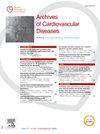用于光药理学控制心脏电活动的无线心脏装置
IF 2.3
3区 医学
Q2 CARDIAC & CARDIOVASCULAR SYSTEMS
引用次数: 0
摘要
心律失常影响约5%的人口,并与高发病率和死亡率相关。随着人口老龄化,这些疾病的发病率不断上升,对健康构成重大挑战。预防或终止心律失常的治疗方法已经存在(抗心律失常药物、植入式心律转复除颤器、消融术……),但它们都有重要的副作用(促心律失常作用、全身毒性……)。光药理学以其高时空分辨率,成为调节心脏电活动的一种有前途的方法。目的:在体外和体内使用外部照明源,成功地证明了其调节离子通道活性的能力。为了进一步的临床应用,本研究的目的是证明植入式心脏装置激活光激活肽和干扰心脏活动的能力。方法一种无线和无电池心脏装置先前已经开发和设计用于大鼠,允许电和光刺激。我们将这个装置植入右心室游离壁。一种可光激活的AaHII类似物(一种致心律失常肽)已在麻醉大鼠中静脉注射,并在380 nm光照下局部激活。结果我们首先成功地改进了手术程序,并通过分析心电图和超声心动图的电学和力学参数、心脏损伤循环标志物和组织学,验证了他们一个多月的耐受性。该装置的耐受性良好超过一个月,没有任何炎症或心律失常的迹象。接下来,我们证明了70%的设备介导的光激活(5/7只大鼠)导致心脏电活动的显著变化,其特征是心电图上T波面积的增加。有趣的是,所有的动物都恢复得很快,证实了肽的局部激活。结论本研究为临床前抗心律失常肽的局部光激活预防或终止心律失常铺平了道路。本文章由计算机程序翻译,如有差异,请以英文原文为准。
Wireless cardiac device for photopharmacological control of cardiac electrical activity
Introduction
Cardiac arrhythmias affect approximately 5% of the population and are associated with high morbidity and mortality. With the aging of the population, their prevalence is increasing, posing a major health challenge. Treatments for preventing or terminating arrhythmias exist (Antiarrhythmic drugs, Implantable cardioverter-defibrillators, ablation techniques…) but they come with important side effects (pro-arrhythmic effects, systemic toxicity…). Photopharmacology, with its high spatio-temporal resolution, emerged as a promising approach for modulating cardiac electrical activity.
Objective
We successfully demonstrated its ability to regulate ion channel activity ex vivo and in vivo using an external illumination source. The objective of this study, to consider further clinical application, is to demonstrate the ability of implantable cardiac device to activate photoactivatable peptides and interfere with cardiac activity.
Method
A wireless and battery free cardiac device has been previously developed and designed for rats allowing electrical and optical stimulations. We implanted the device on the right ventricular free wall. A photoactivatable analogue of AaHII, an arrhythmogenic peptide, has been intravenously injected and activated locally thanks to 380 nm illumination in anesthetized rats.
Results
We first successfully refined the surgical procedure and validated their tolerance over one month by analyzing electrical and mechanical parameters on ECG and echocardiography, circulating markers of heart injury and histology. The device is well tolerated over one month without any signs of inflammation or arrhythmias. We next demonstrated that 70% of the device-mediated photoactivations (5/7 rats), leads to a significant change in the electrical activity of the heart characterized by an increase of the T wave area on the ECG. Interestingly, all animals recovered quickly validating the local activation of the peptide.
Conclusion
This study is very promising for future applications of photopharmacology, and pave the road for local photoactivation of antiarrhythmic peptides to prevent or terminate arrhythmias in preclinical models.
求助全文
通过发布文献求助,成功后即可免费获取论文全文。
去求助
来源期刊

Archives of Cardiovascular Diseases
医学-心血管系统
CiteScore
4.40
自引率
6.70%
发文量
87
审稿时长
34 days
期刊介绍:
The Journal publishes original peer-reviewed clinical and research articles, epidemiological studies, new methodological clinical approaches, review articles and editorials. Topics covered include coronary artery and valve diseases, interventional and pediatric cardiology, cardiovascular surgery, cardiomyopathy and heart failure, arrhythmias and stimulation, cardiovascular imaging, vascular medicine and hypertension, epidemiology and risk factors, and large multicenter studies. Archives of Cardiovascular Diseases also publishes abstracts of papers presented at the annual sessions of the Journées Européennes de la Société Française de Cardiologie and the guidelines edited by the French Society of Cardiology.
 求助内容:
求助内容: 应助结果提醒方式:
应助结果提醒方式:


